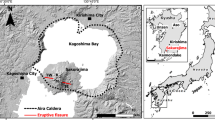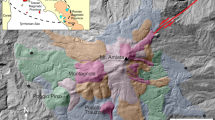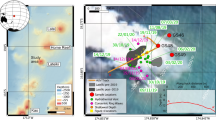Abstract
The Nevado de Toluca, in the middle of the Mexican volcanic belt, has been built by two very dissimilar phases. The first one that lasted more than one million years is mainly andesitic. Numerous massive and autobrecciated lava flows of this phase pass outwards into thick conglomeratic formations. The volume of this primitive volcano represents the essential part of the Nevado.
After an intense periode of erosion, the second phase is of very short duration (about 100.000 years) and is dacitic in nature. Three main episode can be distinguished:
-
1.
Eruption of important ash and pumice pyroclastic flows related to caldera collapse above a shallow magmatic reservoir.
-
2.
Extrusions of several dacitic domes within and outside the caldera with numerous associated «nuées ardentes» surrounding the volcano.
-
3.
Plinian eruption leading to widespread pumiceous air-fall and to the opening of the present crater inside the caldera. Extrusion of a new small dacitic dome and late phreatic explosions.
This second sequence of events can be interpreted as the progressive emptying of the crustal magmatic chamber without refilling by a new magma supply. The most recent activity in the area is represented by monogenic cones and flows of basic andesites outside the central vent system of the Nevado.
Similar content being viewed by others
Bibliographie
Bloomfield, K., 1974,The Age and Significance of the Tenango Basalt, Central Mexico. Bull. Volcanol.,37, n. 4, p. 586–595.
————, 1974,Late Pleistocene Eruptive History of Nevado de Toluca Volcano, Central Mexico. Bull. Geol. Soc. Am.,85, p. 901–906.
----, ----, 1977,Late Quaternary Tephrochronology of Nevado de Toluca Volcano, Central Mexico. Inst. of Geol. Sc. Research Council, Overseas Geol. and Min. Res., n. 46, 15 p.
Fisher, R. V., 1979,Models for Pyroclastic Surges and Pyroclastic Flows. J. Volc. and Geothermal Res.,6, p. 305–318.
Mooser, F., 1968,The Mexican Volcanic Belt: Structure and Development. Formation of Fractures by Differential Crustal Heating. Pan Am. Symp. on the Upper Mantle, Mexico D.F.,2, p. 15–22.
Ordonez, E., 1902,Le Xinantecatl ou volcan Nevado de Toluca. Soc. Sc. «Antonio Alzate» Mem.,18, p. 83–112.
Roobol, M. J., Smith A. L., 1975,A Comparison of Recent Eruptions of Mt Pelée, Martinique, and Soufrière, St. Vincent. Bull. Volcanol.,39–2, p. 1–27.
Waitz P., 1909,Excursion géologica al Nevado de Toluca. Soc. Geol. Mexicana Bol.,6, p. 113–117.
Author information
Authors and Affiliations
Rights and permissions
About this article
Cite this article
Cantagrel, J.M., Robin, C. & Vincent, P. Les grandes étapes d’évolution d’un volcan andésitique composite: Exemple du Nevado de Toluca (Méxique). Bull Volcanol 44, 177–188 (1981). https://doi.org/10.1007/BF02597703
Received:
Revised:
Accepted:
Issue Date:
DOI: https://doi.org/10.1007/BF02597703




